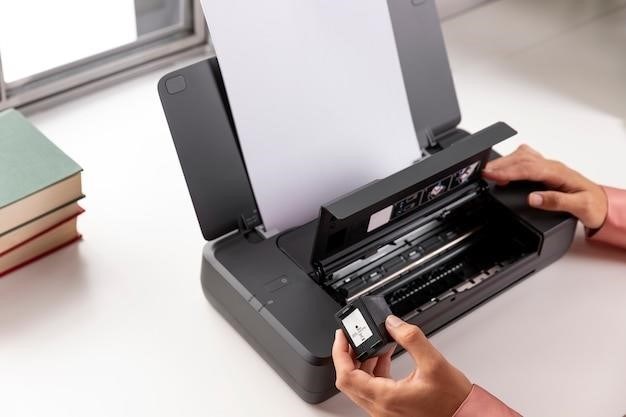epson ff680w manual
Epson FastFoto FF-680W⁚ A Comprehensive Guide
This guide provides a comprehensive overview of the Epson FastFoto FF-680W, a high-speed photo scanner designed for efficient and effortless digitization of your cherished memories. From setting up the scanner to troubleshooting common issues, this guide covers all aspects of using the Epson FastFoto FF-680W.
Introduction
Welcome to the world of effortless photo digitization with the Epson FastFoto FF-680W, a scanner designed to streamline your photo archiving process. This user-friendly scanner combines speed, efficiency, and advanced features to transform your physical photo collection into a digital treasure trove. Whether you’re a seasoned photographer or just starting to digitize your memories, the Epson FastFoto FF-680W offers a seamless solution for preserving your precious photos.
With its intuitive design, the FF-680W simplifies the scanning process. The scanner automatically feeds and scans photos at remarkable speed, allowing you to digitize large collections with minimal effort. The included Epson ScanSmart software provides a user-friendly interface, enabling you to easily organize, edit, and share your newly digitized photos.
This guide will walk you through every step of using the Epson FastFoto FF-680W, from setting it up to scanning your photos and utilizing the various features available. By the end of this guide, you’ll have a comprehensive understanding of the Epson FastFoto FF-680W and be confident in your ability to preserve your memories in a digital format.
Setting Up Your Epson FastFoto FF-680W
Setting up your Epson FastFoto FF-680W is a straightforward process that requires minimal effort. To get started, you’ll need to connect the scanner to your Wi-Fi network and install the Epson ScanSmart software. This software is designed to simplify the scanning process and provide you with a range of tools for managing your digitized photos. Follow these steps to set up your Epson FastFoto FF-680W and begin digitizing your memories⁚
Unpack and Connect⁚ Carefully remove the scanner from its packaging and connect it to a power source using the provided power cable.
Place the Scanner⁚ Choose a flat, stable surface to place the scanner. Ensure that the scanner is positioned in a well-lit area to optimize scanning quality.
Connect to Wi-Fi⁚ Once the scanner is powered on, you can connect it to your Wi-Fi network. Refer to the user manual or online instructions provided by Epson for detailed guidance on connecting the scanner to your wireless network.
Install Epson ScanSmart⁚ Download and install the Epson ScanSmart software from the Epson website or the included CD. This software is essential for controlling the scanner and managing your digitized photos.
2.Connecting to Wi-Fi
Connecting your Epson FastFoto FF-680W to your Wi-Fi network allows you to scan photos wirelessly and access them from your computer or mobile device. This convenient feature eliminates the need for a physical USB connection, making the scanning process even more effortless. To connect the scanner to your Wi-Fi network, follow these steps⁚
Ensure Wi-Fi is Enabled⁚ Make sure that the Wi-Fi settings on your scanner are enabled. You can usually access these settings by pressing the Wi-Fi button on the front panel of the scanner.
Select Your Network⁚ Once the Wi-Fi settings are enabled, the scanner will begin searching for available Wi-Fi networks. Select your home or office network from the list of available networks.
Enter the Password⁚ You will be prompted to enter the password for your Wi-Fi network. Carefully enter the correct password to establish a secure connection.
Confirm Connection⁚ Once you have entered the password, the scanner will attempt to connect to your Wi-Fi network. If the connection is successful, the Wi-Fi and power indicators on the front panel of the scanner will light up blue.
2.Installing Epson ScanSmart
Epson ScanSmart is the essential software that brings your Epson FastFoto FF-680W to life. It’s your bridge between the scanner and your computer, enabling you to scan photos and documents with ease. Installing Epson ScanSmart is a straightforward process that ensures you’re ready to digitize your memories. To install Epson ScanSmart, follow these steps⁚
Download the Drivers⁚ The first step is to download the latest drivers and utilities package for your Epson FastFoto FF-680W. You can find this package on the Epson website, specifically in the support section for your scanner model.
Run the Installer⁚ Once the download is complete, locate the downloaded file and double-click it to launch the installer. Follow the on-screen prompts, which will guide you through the installation process.
Connect the Scanner⁚ During the installation process, you might be prompted to connect your scanner to your computer. If you’re using a USB connection, connect the scanner now. If you’ve connected to Wi-Fi, the scanner should be automatically recognized.
Complete the Installation⁚ The installer will complete the installation process, and you’ll be ready to use your Epson FastFoto FF-680W with Epson ScanSmart.
Epson FastFoto FF-680W Features

The Epson FastFoto FF-680W is packed with features designed to make digitizing your photos and documents a breeze. From its high-speed scanning capabilities to its versatile connectivity options, the FF-680W offers a range of features to meet your needs⁚
- High-Speed Scanning⁚ With its advanced technology, the FF-680W can scan photos at an impressive rate, allowing you to digitize your entire photo collection quickly and efficiently.
- Automatic Photo Correction⁚ The scanner automatically corrects common photo imperfections, such as faded colors, red-eye, and dust and scratches, ensuring that your digital copies are clear and vibrant.
- Document Scanning⁚ Beyond photos, the FF-680W can also scan documents, making it a versatile tool for archiving important papers, receipts, or business documents.
- Wi-Fi Connectivity⁚ The FF-680W offers wireless connectivity, allowing you to scan directly to your computer, smartphone, or tablet without the need for a physical connection.
- Epson ScanSmart Software⁚ The FF-680W comes bundled with Epson ScanSmart software, a user-friendly application that simplifies the scanning process, offering intuitive controls and helpful features.
These features combined make the Epson FastFoto FF-680W a powerful and convenient tool for anyone looking to preserve their memories and organize their important documents.
Scanning with Epson FastFoto FF-680W
Scanning with the Epson FastFoto FF-680W is a straightforward process, designed to be simple and efficient. The scanner’s intuitive design and accompanying software make digitizing your photos and documents a breeze. Here’s a step-by-step guide to get you started⁚
- Power On and Connect⁚ Turn on the FF-680W and connect it to your computer or device using a USB cable or Wi-Fi. If connecting wirelessly, make sure your device and the scanner are on the same network.
- Open Epson ScanSmart⁚ Launch the Epson ScanSmart software on your computer. The software will guide you through the scanning process and provide options for customization.
- Load Your Media⁚ Place your photos or documents in the scanner’s document feeder or on the flatbed, depending on the type and size of your media.
- Select Scan Settings⁚ Choose the desired scan resolution, color mode, and other settings based on your needs. For photos, you may want to select a higher resolution for detailed images.
- Start Scanning⁚ Initiate the scanning process using the software’s interface. The FF-680W will scan your photos or documents quickly and efficiently.
- Save and Manage⁚ After scanning, the software allows you to save your digital copies to your computer, cloud storage, or other desired locations. You can also easily manage and organize your scanned files.
With its user-friendly interface and automated features, the Epson FastFoto FF-680W makes scanning a hassle-free experience, allowing you to preserve your memories and organize your documents with ease.
4.1. Scanning Photos
The Epson FastFoto FF-680W excels at scanning photos, making it an ideal choice for digitizing your cherished memories. Its high-speed capabilities and advanced features ensure that your precious photos are scanned with accuracy and detail. Here’s how to scan your photos using the FF-680W⁚
- Prepare Your Photos⁚ Before scanning, ensure your photos are clean and free of dust or debris. For best results, gently brush away any particles with a soft brush.
- Load Photos into Feeder⁚ The FF-680W’s automatic document feeder (ADF) can accommodate up to 100 photos at once, making it perfect for batch scanning. Load your photos into the ADF, making sure they are aligned correctly.
- Select Photo Settings⁚ In Epson ScanSmart, choose the “Photo” scan mode. The software will automatically optimize settings for capturing photo details and colors accurately.
- Adjust Resolution⁚ Depending on the size and quality of your photos, you can adjust the scan resolution; For high-quality prints, a higher resolution like 600 dpi or higher is recommended.
- Start Scanning⁚ Initiate the scan using the software’s interface. The FF-680W will quickly scan your photos, capturing all the details and colors.
- Review and Save⁚ After scanning, Epson ScanSmart allows you to review your scanned photos, make any necessary adjustments, and then save them to your computer or cloud storage.
The Epson FastFoto FF-680W makes scanning your photo collection a simple and efficient task, preserving your memories for generations to come.
4.2. Scanning Documents
While the Epson FastFoto FF-680W is primarily designed for scanning photos, it can also handle document scanning with ease. Its high-speed capabilities and advanced features ensure that your important documents are digitized with accuracy and clarity. Here’s how to scan documents using the FF-680W⁚
- Prepare Your Documents⁚ Before scanning, ensure your documents are clean and free of wrinkles or creases. For best results, gently flatten any curled pages.
- Load Documents into Feeder⁚ The FF-680W’s automatic document feeder (ADF) can accommodate up to 100 sheets of paper, making it ideal for batch scanning. Load your documents into the ADF, ensuring they are aligned correctly.
- Select Document Settings⁚ In Epson ScanSmart, choose the “Document” scan mode. The software will automatically optimize settings for capturing text and images accurately;
- Adjust Resolution⁚ Depending on the complexity of your documents and their intended use, you can adjust the scan resolution. For standard documents, a resolution of 300 dpi is usually sufficient.
- Start Scanning⁚ Initiate the scan using the software’s interface. The FF-680W will quickly scan your documents, capturing all the details and text.
- Review and Save⁚ After scanning, Epson ScanSmart allows you to review your scanned documents, make any necessary adjustments, and then save them to your computer or cloud storage.
The Epson FastFoto FF-680W simplifies document scanning, allowing you to easily digitize important paperwork and create digital archives for your records.
Epson FastFoto FF-680W Software
The Epson FastFoto FF-680W comes with a suite of powerful software designed to enhance your scanning experience. These user-friendly applications streamline the entire process, from capturing images to organizing and editing your digitized photos and documents. Whether you’re a novice or an experienced user, Epson’s software provides the tools you need for a seamless and efficient workflow.
Epson’s software offers a range of features to make scanning and managing your photos and documents a breeze. You can easily adjust scan settings, optimize image quality, and even apply basic editing functions to enhance your digital collection. Additionally, the software facilitates seamless integration with popular photo editing and cloud storage platforms, allowing you to share your memories and important documents effortlessly.
5.1. Epson ScanSmart
Epson ScanSmart is the primary software application designed for the Epson FastFoto FF-680W. This intuitive software simplifies the scanning process, making it accessible to users of all skill levels. ScanSmart guides you through each step, from selecting the scan type to choosing the output format and destination. Its user-friendly interface and automated features make it a breeze to digitize your photos and documents quickly and efficiently.
With ScanSmart, you can easily adjust settings to optimize image quality based on your specific needs. For example, you can select from pre-defined scan modes tailored for different types of media, such as photos, documents, or business cards. You can also fine-tune settings like resolution, color depth, and brightness to achieve the desired results for your digital collection. Moreover, ScanSmart offers features like automatic cropping and red-eye reduction, ensuring your scanned images look their best.
5.2. Epson Scan 2 Utility
While Epson ScanSmart provides a streamlined scanning experience, the Epson Scan 2 Utility offers a more comprehensive set of features for advanced users. This versatile software allows for greater control over the scanning process, offering a range of options for customizing your scans. With Epson Scan 2, you can fine-tune settings like resolution, color depth, brightness, and contrast to achieve the desired level of detail and clarity. You can also select from various scan modes tailored for different types of media, including photos, documents, and even 3D objects.
Epson Scan 2 Utility also provides features like automatic document skew correction, which ensures scanned documents are aligned perfectly. You can even choose to save your scans in various formats, including JPEG, TIFF, and PDF, ensuring compatibility with different applications and devices. Additionally, Epson Scan 2 offers advanced features like multi-page scanning, allowing you to scan multiple documents at once, and batch processing, enabling you to scan and save multiple images with a single click.
Troubleshooting
While the Epson FastFoto FF-680W is designed for user-friendliness, you may encounter occasional issues. This section provides guidance on resolving common problems, ensuring a smooth and seamless scanning experience. If you’re facing difficulties connecting to Wi-Fi, ensure the scanner is powered on and the Wi-Fi settings are enabled. Check the Wi-Fi and power indicator lights on the scanner’s front panel, which should illuminate blue when connected to a router.
Driver issues can also arise, particularly when updating your operating system. To address driver problems, consider using a dedicated driver updater tool like PC HelpSoft Driver Updater, which can automatically find and install the latest and original drivers for your scanner. If you’re experiencing issues with the Epson ScanSmart software, make sure your Windows 11 and Epson scanner are on the same internet connection. Ensure all wired connections are securely plugged in.
6.1. Wi-Fi Connection Issues
Connecting your Epson FastFoto FF-680W to your Wi-Fi network is a crucial step for seamless scanning and data transfer. If you’re encountering difficulties establishing a connection, follow these steps to troubleshoot the issue. Firstly, ensure that the scanner is powered on and the Wi-Fi settings are enabled. Locate the Wi-Fi button on the scanner’s front panel and press it once to activate the Wi-Fi settings. When successfully connected to your router, both the Wi-Fi and power indicator lights on the scanner’s front panel should illuminate blue.
If the blue lights aren’t illuminating, check your router’s settings and ensure that the Wi-Fi network is broadcasting correctly. Verify that the scanner is within range of your router and that there are no obstacles hindering the signal. Try restarting both the scanner and your router to refresh the connection. If the issue persists, refer to the Epson FastFoto FF-680W user manual for more detailed troubleshooting steps or contact Epson support for assistance.


















